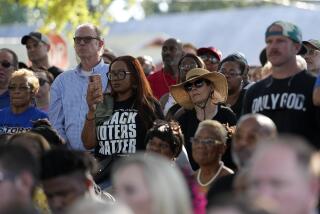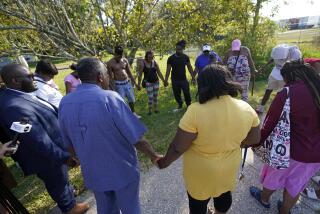‘You’re not welcome here.’ The painful racial reckoning playing out in a Wendy’s parking lot
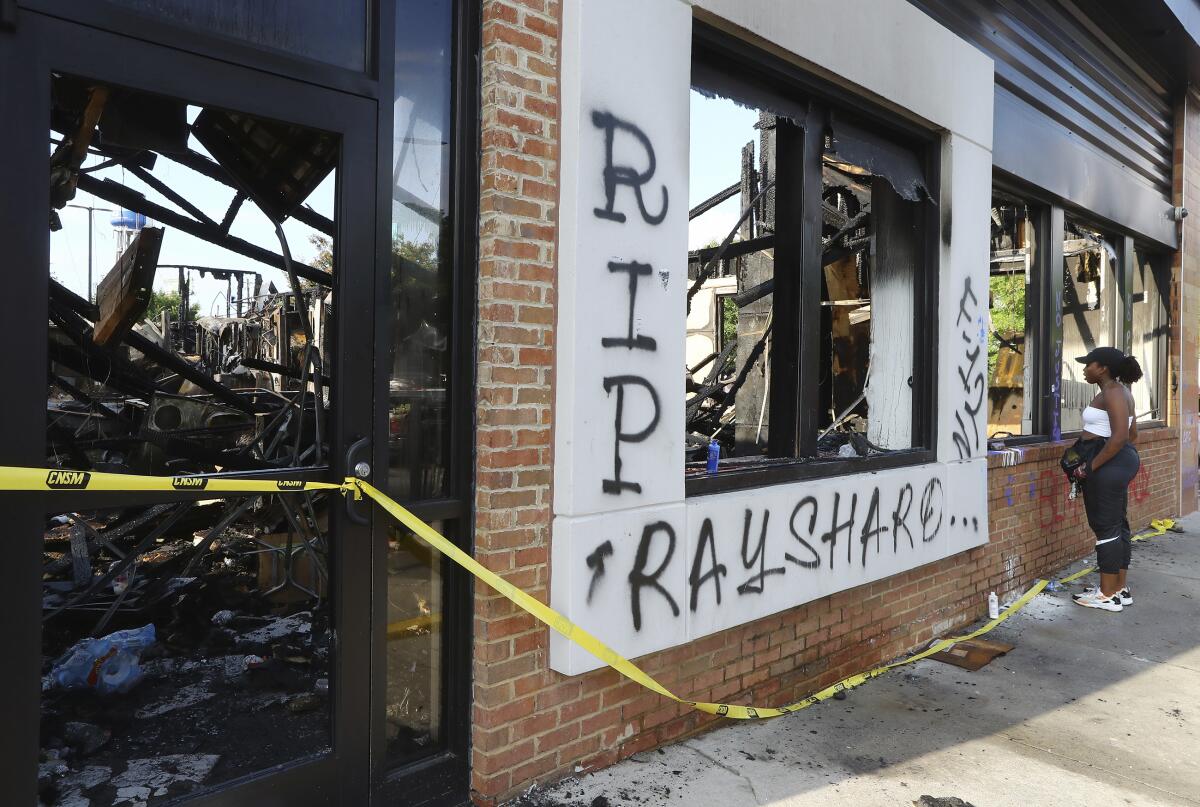
ATLANTA — In the early morning of Tuesday, bulldozers and backhoes moved in to demolish the charred ruins of a Wendy’s fast-food restaurant that had become a shrine, a mini occupation zone, and rallying point for protesters since the building was set ablaze following the fatal police shooting of Rayshard Brooks.
Activists who occupied the parking lot around the former drive-through restaurant hoped to create a space that would affirm Black lives, even naming the site the Rayshard Brooks Peace Center.
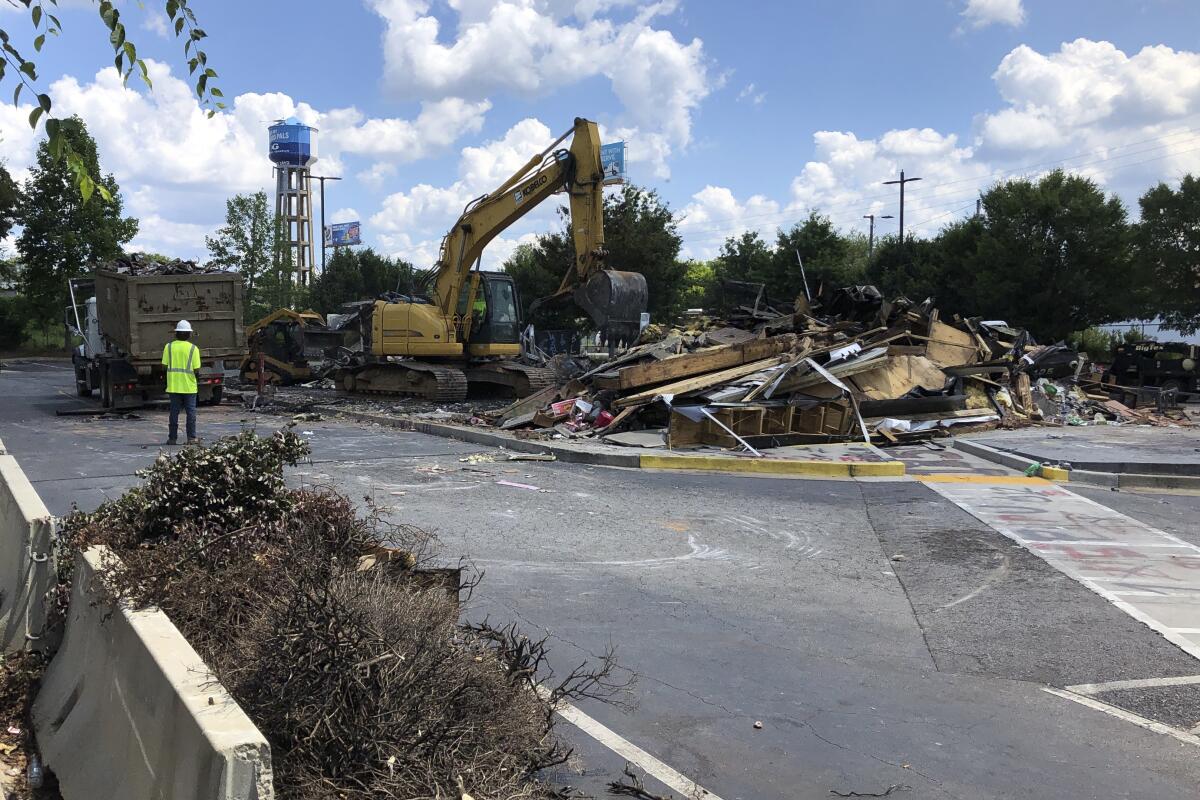
But in the three weeks that followed the June 12 shooting of the 27-year-old Black father, the block around the Wendy’s witnessed a dramatic uptick in violence. As city officials and police ceded the area to armed men with guns, there were threats on journalists, assaults and shootings — one of which resulted in the death of an 8-year-old Black girl.
On July 4, Secoriea Turner was killed when a group of armed Black men who blocked the road a few hundred feet from the Wendy’s shot at the Jeep she rode in with her mother and an adult friend. According to her mother, they were shot as they attempted to avoid a makeshift barrier.
The killing of Turner has left this city, already bruised after weeks of protests against racial inequality, grappling with a series of questions about control. If police are not to be trusted to provide law and order in the community — as many activists say — how should the community police itself? Is anyone responsible for maintaining peace? And who should be held accountable when things go wrong?
While activists say no one they know was responsible for the shooting — and point out that wielding firearms is not a crime in this open-carry state — city leaders insisted on dismantling the camp.
“Enough is enough,” Mayor Keisha Lance Bottoms said at a July 5 news conference. “We’re fighting the enemy within when we are shooting people up in the streets.”
The leaders of the encampment say city officials were unfair in citing the violence to shut it down and accuse them of shifting the focus away from police brutality in poor, Black communities and attempting to discredit the Black Lives Matter movement.
“What happens on the other side of the street, we can’t control,” the camp’s de-facto leader, Rayshard Brooks’ sister, who calls herself Lady A, yelled at the Atlanta Police Department’s interim police chief last week as police and sanitation crews dismantled the camp. “Me and my people, we’re peaceful,” she told him. “We just want my brother’s name to live on in a more positive way.”
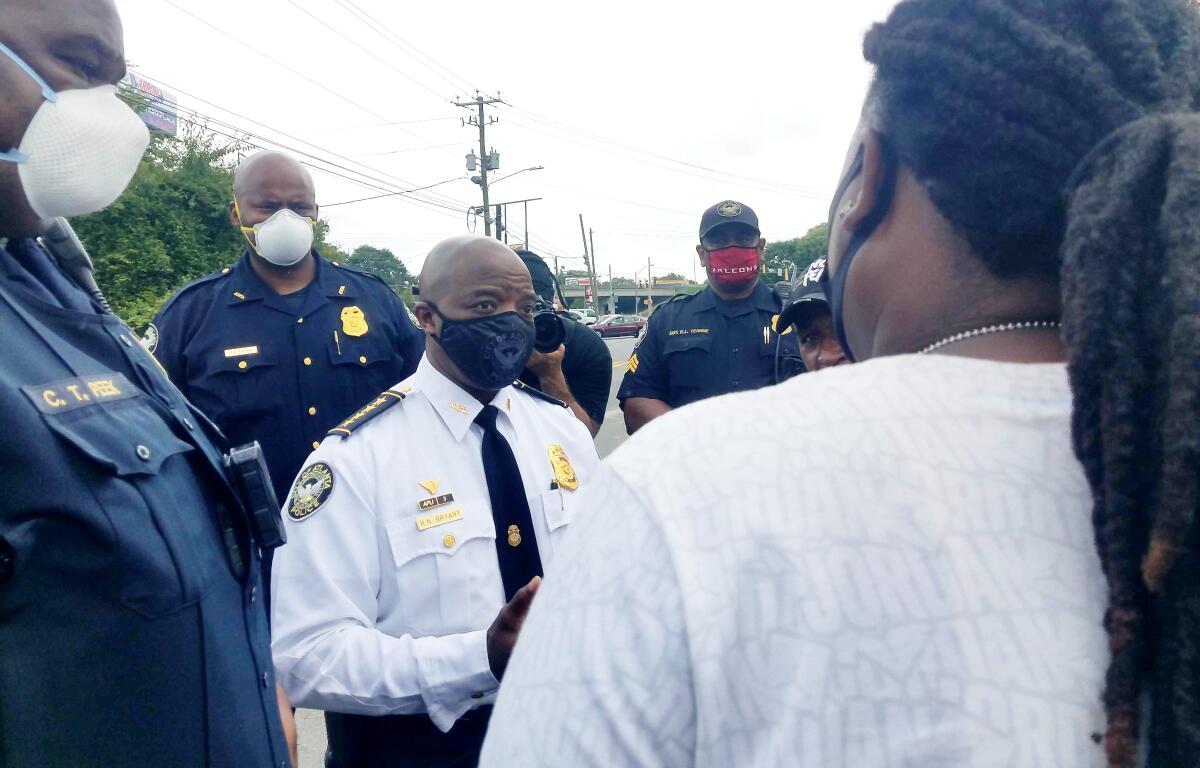
Police officers had already scooped up withered bouquets of roses, candles, placards and plush teddy bears and dropped them into clear plastic trash bags. As activists watched front-end loaders haul concrete barriers to block access to the site, they described it as a place of peace and healing.
Around the mangled husk of the former Wendy’s, they had built outdoor tents, showers for the homeless and a community garden. On the day of Secoriea’s murder, the camp hosted a July 4 block party and cookout with social justice workshops.
“What was happening here was an experiment in deep, deep love,” said a Black activist, teacher and urban farmer who declined to give her name.
Not all residents in the predominantly Black communities surrounding the Wendy’s felt the love. While some unconditionally supported the occupation, others who back the movement against police brutality believe the scene spiraled out of control and became a magnet for violence.
“It was a peaceful protest at first, then people came with guns,” Derante Wilkins, an 18-year-old CVS cashier who lives in the nearby community of Mechanicsville, said as he stood in the parking lot of a boarded-up package store watching police fan through the area. “Now they’ve messed up the whole purpose of the protest.”
::
From the beginning, the tactics of those who gathered at the Wendy’s raised some eyebrows — even among residents who support the Black Lives Matter movement.
On the first morning of the protests – the day after Brooks was shot in the back by police in the Wendy’s parking lot – the mood was raw as dozens of local residents descended on the restaurant to vent their anger at the killing. Before long, protesters spilled out on the four-lane road and blocked a white driver from passing. As a stand-off between the motorist and protesters ensued, Black drivers were allowed to pass through.
By the end of that night, the Wendy’s was set ablaze.
Over the next few days, as young Black, white and brown activists and residents flocked to the site to light candles and snap selfies, many knelt before a makeshift altar decorated with placards: “I CAN’T BREATHE,” “ABOLISH THE POLICE” and “MELANIN IS NOT A CRIME.”
One message, that remained up for days, was more ominous: “FOR EVERY BODY YOU’VE TOOK IM TAKING 5 OF YALLS ON THE FOURTH OF JULY.”
White residents of surrounding neighborhoods and reporters who ventured to the Wendy’s to look at the memorial were frequently interrogated by Black men and asked to leave. Armed men began to patrol.
At the same time, the Police Department pulled back. The day after the local district attorney announced he would bring felony murder charges against the officer who shot Brooks, more than 65% of Atlanta police sat out work in protest.
Tensions across Atlanta escalated on Juneteenth when protesters who shut down a busy traffic intersection four miles north in Midtown were confronted by a white man who displayed an AR-15 and then hit a Black protester with his sedan as he fled the scene. Demonstrators shot at his car.
Later that night, a 24-year-old female protester on the street near Wendy’s was shot in the leg by a Black man. At least one witness told the police that a shootout ensued after a white man and woman had shot at the crowd from a car, prompting a hail of crossfire. Soon, roadblocks manned by Black men with rifles and handguns were set up outside the Wendy’s.
On June 20, a white couple reported that they were injured when armed Black men attacked them with rocks and damaged their car as they passed the site on their way to the interstate. That evening, a 35-year-old Black man was shot in the leg and at least one witness said the suspect was a white man who had fled the scene in a Dodge Challenger.
Later that night, a Black journalist was punched about half a dozen times in the Wendy’s parking lot by a group of young Black men with guns who threatened to kill him after he refused to hand over his cellphone.
“If activists allow such militance to continue,” the freelance reporter, George Chidi, warned, “it will likely drive the broader public into a call for police intervention and discredit the movement toward systemic reform.”
Two weeks later, Secoriea Turner was dead. A day after that, there was another fatal shooting near the Wendy’s. On July 5, a 53-year-old Black man, Christopher Brooks, was killed at a gas station about 500 feet from the restaurant when a shootout broke out. Two other men were injured in a crossfire.
Police this week charged a 19-year-old Black man with felony murder and aggravated assault in Turner’s death, and they are still looking for other persons of interest, including a Black man who appeared on video surveillance footage carrying an AR-15.
The 19 year-old, who turned himself in Wednesday, told a local TV outlet he was a peaceful protester who witnessed the shooting. He denied firing his weapon.
::
In the tiny historic Black neighborhood of Peoplestown, poor but gentrifying with about 2,700 residents, there is almost universal support for reforming the Police Department. The day after Rayshard Brooks was shot, the local neighborhood planning unit issued a list of 30 demands to divest in policing and reinvest in communities. A few weeks later, dozens of residents marched half a mile to the Wendy’s to show their solidarity with activists at the since-dismantled camp.
Ethel Floyd, a 65-year-old Black resident who joined the solidarity march, said she supported the movement and bought a Black Lives Matter T-shirt. But she was shocked to see young men toting guns.
“I just couldn’t believe it,” Floyd said. “Why you need guns?”
Others defended the presence of armed men around the site, on the basis that they were needed to fend off white counterprotesters.
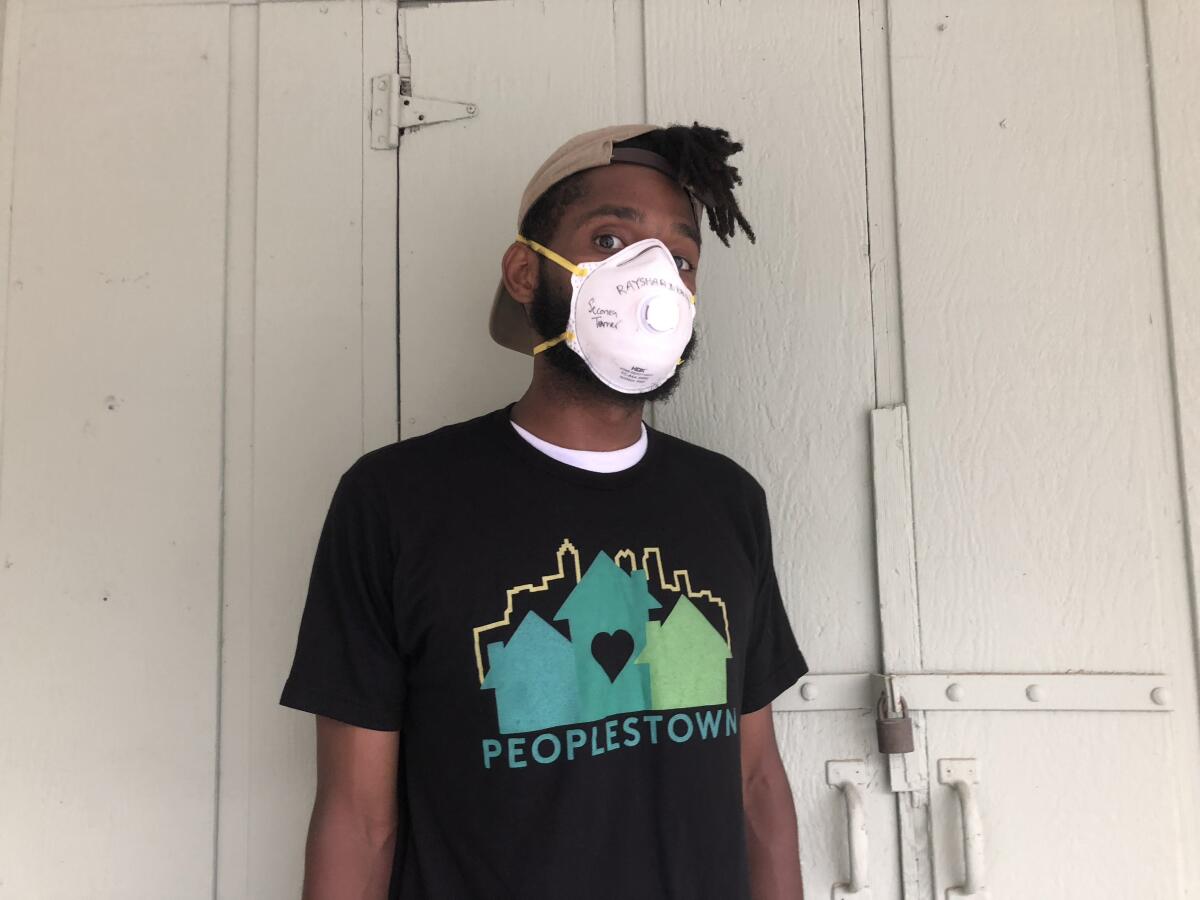
“There was a need for protection,” said Christopher Lemons, a 34-year-old Black urban farmer and president of the Peoplestown Neighborhood Assn. “But those people were not trained or qualified to be protectors.”
Lemons said he was sad to see the people ejected from the camp. Over the course of their occupation, activists had sought to build momentum for making the site permanent, he said, asking Wendy’s to relinquish the deed to the land and getting buy-in from local officials for creating a new community space.
“There were outside agitators coming down into our neighborhood,” Lemons said one evening last week. “I just really hate that people try to make it look like it was the protesters that were being violent. That was not the case.”
While some residents, business owners and civil rights groups blame the mayor and the Police Department for not stepping in to restore order, many activists at the site said a stronger police presence would have only made the situation worse.
Columbus Ward, the 66-year-old chair of the local citizens’ Neighborhood Planning Unit and a longtime Black community activist who supported the occupation, visited the site to try to help organize and discourage protesters from blocking the streets.
“I understand the protesters or the people who occupy that space,” he said. “But also, I can see stuff get out of hand.... People are tired, frustrated and traumatized.”
Ward believes in nonviolence, but he said he was reluctant to focus on Black men carrying or firing guns. It was more important, he said, to take a step back and address the underlying systemic racism that had left so many Black residents languishing in poverty.
“See, we need to understand the real problem,” he said. “We wouldn’t have some of these issues if we dealt with the real issue of poverty. We want to deal with what I call these little incidents that are very negative, but not deal with the problem.”
Last Saturday, more than 100 activists, carrying signs saying “ABOLITION NOW” AND “THIS LAND IS OUR LAND,” marched to the ruins of the now-demolished building for a rally to “Take Back the Wendy’s.”
“We’re here because we demonstrated peace and we was pushed out,” Lady A bellowed into a bullhorn. “I don’t understand. How can you be so against peace?”
A few minutes after Lady A wrapped up, a Black woman confronted the Black journalist Chidi who had been assaulted at the site three weeks before, asking him why he had come back.
Before long, a group of Black men sidled up and stood next to Chidi. Among the group, he said, he recognized two men who previously assaulted him.
“You got to go, bro,” a man in the crowd yelled as more men surrounded Chidi, forming a circle around him.
A Black activist who tried to intervene, suggesting they give the reporter the benefit of the doubt, was asked if he was his security.
“You’re not welcome here,” a female activist yelled at Chidi. “If you don’t feel safe here, you should leave.”
The reporter walked away. Then the Black activist who had tried to calm the situation was also asked to leave.
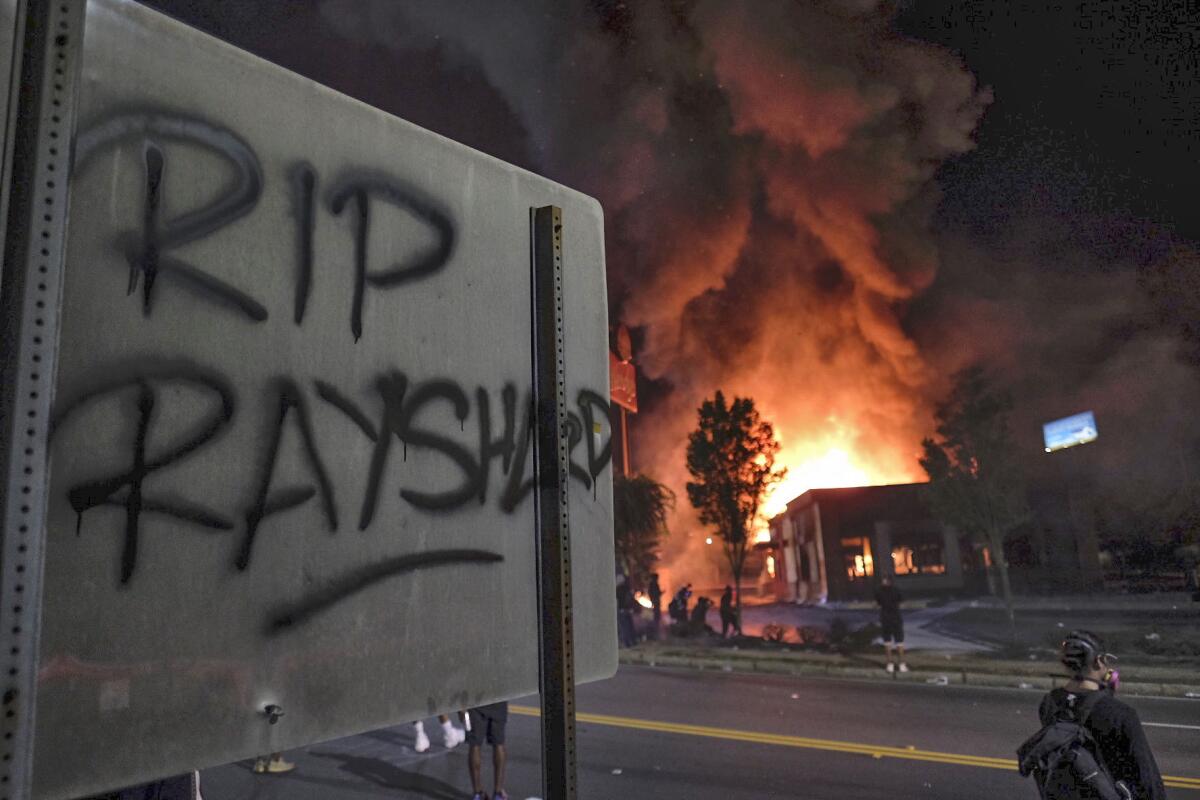
More to Read
Sign up for Essential California
The most important California stories and recommendations in your inbox every morning.
You may occasionally receive promotional content from the Los Angeles Times.
